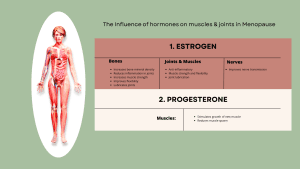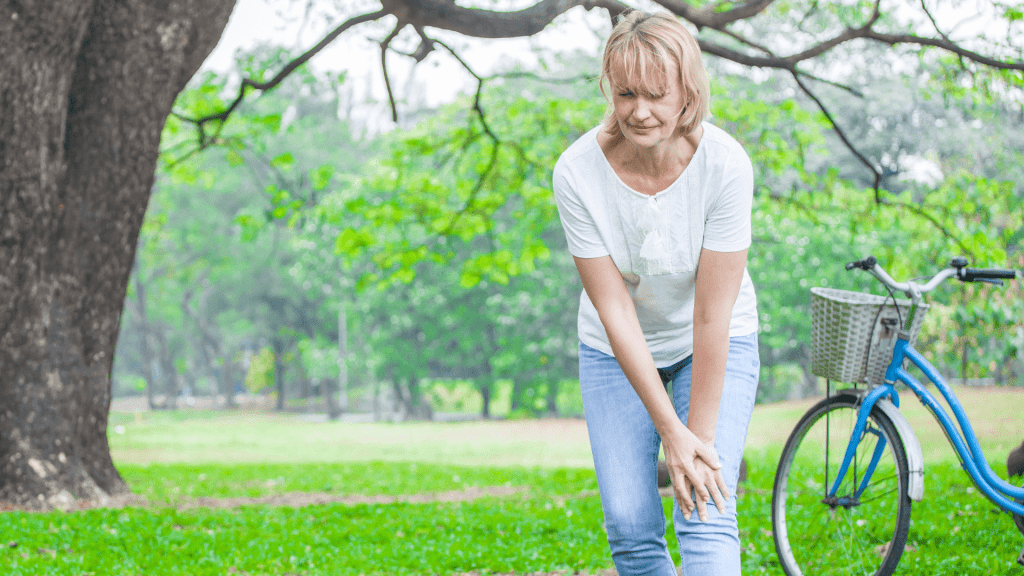“Why do my joints feel stiffer these days?”
“Why am I losing strength even though I haven’t changed much?”
“Is this just part of getting older?”
If you’ve ever asked yourself these questions in midlife, you are so not alone. In my clinic, I’ve lost count of how many women sit across from me and describe the same story: creeping aches, stiffness that seems to arrive overnight, muscles that don’t bounce back the way they used to, and that unsettling sense that their body is slowing down.
Here’s the thing: it’s not just in your head. And it’s not simply “old age.”
There’s actually a name for what’s going on: Musculoskeletal Syndrome of Menopause (MSM).
What is Musculoskeletal Syndrome of Menopause?
This is a way of describing the cluster of changes that can happen to your muscles, joints, tendons, and bones when estrogen levels start to decline in menopause.
Think of it as your body’s way of waving a flag and saying: “Hey, hormones matter here too!”
Some of the most common signs include:
- Achy or stiff joints, especially first thing in the morning.
- Muscles that feel weaker or take longer to recover after activity.
- Tendon issues (like shoulder or hip pain) that just won’t settle.
- Bone loss, putting you at higher risk of osteoporosis or fractures.
Why does this happen?
Here’s the science, explained simply.
Estrogen isn’t just about periods and hot flushes. It’s like a body maintenance hormone. It helps keep muscles strong, joints lubricated, tendons springy, and bones dense. When estrogen drops, that maintenance crew slows down…and you start to feel the difference.
- Muscles: Without estrogen’s support, muscle power and endurance decline, so everyday activities can feel harder.
- Joints: Joints lose some of their lubrication, leaving you feeling stiffer and achier (that morning stiffness sound familiar?).
- Tendons: With less estrogen, collagen production slows, making tendons more prone to injury and slower to heal.
- Bones: Estrogen normally helps balance bone breakdown and rebuilding. Without it, bone is broken down faster than it’s replaced, which speeds up bone loss.

The result? A perfect storm of stiffness, soreness, and weakness that many women chalk up to “just aging.” But really, it’s a hormonal shift you can absolutely do something about.
Researchers describe it as five main changes that happen when estrogen falls:
- Increased inflammation
- Reduced bone density → osteoporosis
- Higher rates of arthritis and joint pain
- Muscle loss (sarcopenia)
- Slower muscle repair due to fewer muscle stem cells
If you’ve been ticking a few of these boxes lately, you’re not imagining it.
What you can do about it
The good news? You have tools. This doesn’t have to be the “new normal.” With the right strategies, you can take back strength, reduce pain, and protect your body for the years ahead.
4 tips for less pain and more movement:
- Strength training is your BFF → Resistance training (weights, bands, or bodyweight) rebuilds muscle and bone.
- Tendon strengthening → Slow, controlled exercises (like heel raises, bridges, wall sits) support your tendons.
- Balance & mobility work → Reduces falls and helps you move with confidence.
- Professional support → A physiotherapist, menopause coach, or GP can guide you on hormone therapy, pain relief, or exercise strategies tailored to your needs.
Conclusion
If your body feels different in midlife — achy, stiff, or weaker, you are not imagining it, and you are definitely not alone. Musculoskeletal Syndrome of Menopause is real, and it helps explain why so many women experience this shift.
But here’s the hopeful part: understanding why it happens means you can start to create a plan and with the right mix of movement, smart nutrition, and support, you can ease the aches, rebuild your strength, and step into this new chapter of your life with confidence.
For extra guidance on how to reclaim your power in Menopause, I’m diving deeper into this exact topic in my free webinar, From Worn Out to Warrior Webinar, where I’ll share practical strategies to reduce pain, rebuild strength, and create your Menopause Survival Kit. Save your spot here.
References & Further Reading
- NIH Journal – Musculoskeletal syndrome of menopause
- ScienceDirect – Estrogen, inflammation, and musculoskeletal health
- Jean Hailes – Menopause Symptoms

